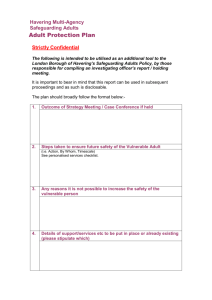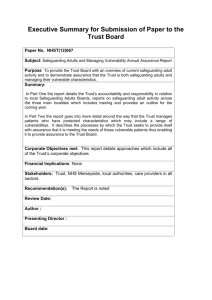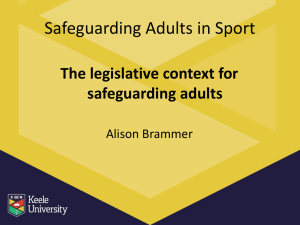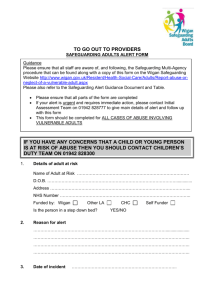Guidance notes for amending the templates
advertisement
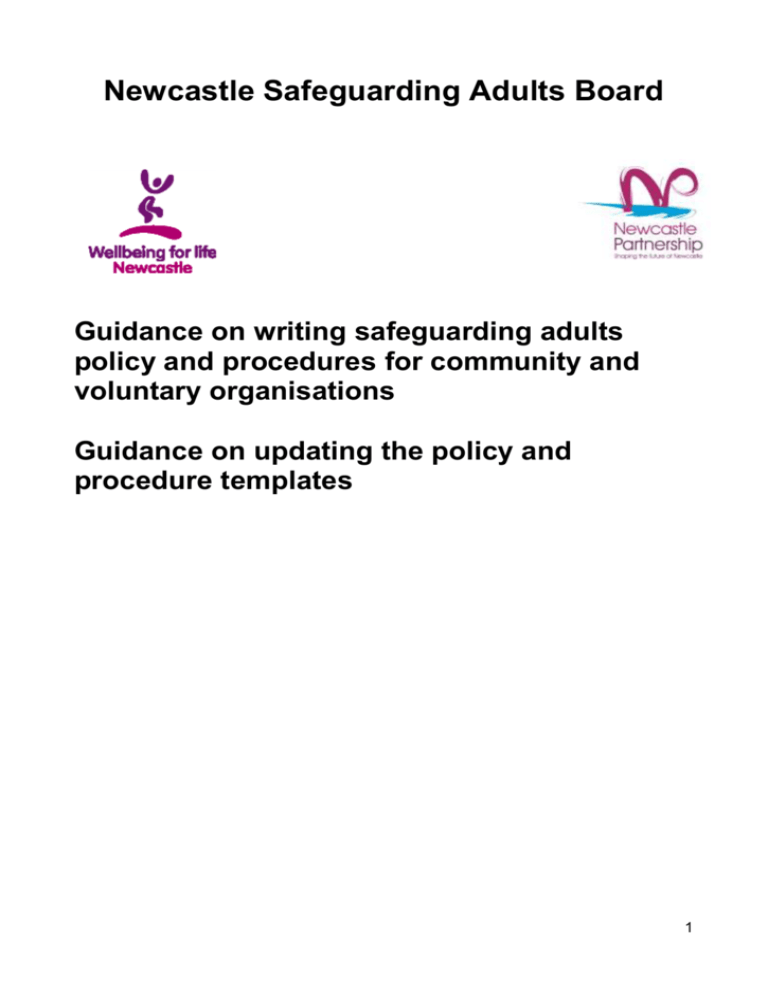
Newcastle Safeguarding Adults Board Guidance on writing safeguarding adults policy and procedures for community and voluntary organisations Guidance on updating the policy and procedure templates 1 Introduction This guidance is taken from Newcastle Safeguarding Adults Board MultiAgency Policy and Procedures and will assist you to formulate safeguarding adults policy and procedures for your organisation. There are two main sections to the document. One section provides suggested templates for both a safeguarding adults policy and a safeguarding adults procedure for your organisation. The other section provides guidance on amending those templates in order that they are suitable to your needs. All agencies must refer to the multi-agency policy and procedures for detailed safeguarding adults guidance, however in addition to this it is important that each organisation has their own policy and procedure to demonstrate their commitment to safeguarding adults; as well as providing a clear outline of roles and responsibilities for anyone who works or volunteers for the organisation. The Department of Health stipulates that: “Provider agencies will produce for their staff a set of internal guidelines which relate clearly to the multi-agency policy and which set out the responsibilities of all staff to operate within it” (No Secrets, Department of Health, 2000). They should include guidance on: identifying vulnerable adults who are particularly at risk; recognising risk from different sources and in different situations and recognising abusive behaviour from other service users, colleagues, and family members; routes for making a referral and channels of communication within and beyond the agency; assurances of protection for whistle blowers; working within best practice as specified in contracts; working within and co-operating with regulatory mechanisms; and working within agreed operational guidelines to maintain best practice in relation to: - challenging behaviour - personal and intimate care - control and restraint - sexuality - medication - handling of user’s money - risk assessment and management. 2 Background Safeguarding adults means all work which enables an adult to retain independence, wellbeing and choice and live a life that is free from abuse and neglect. It is about preventing abuse and neglect as well as promoting good practice for responding to concerns on a multi-agency basis. Everyone has the right to live their lives free from violence and abuse. That right is underpinned by the duty on public agencies under the Human Rights Act (1998). This places a duty on public organisations to enable adults at risk of neglect or abuse to access the advice, support and interventions they need to minimise the risk of further abuse, and stop it wherever possible. It follows that all citizens should have access to relevant services including the civil and criminal justice system and victim support services. Remedies available should also include measures that achieve behaviour change by those who have perpetrated abuse or neglect. Safeguarding adults is about trying to make sure that vulnerable adults do not get harmed, and knowing what to do if anyone in your organisation or service is worried about a vulnerable adult. Your service or organisation should have safeguards in place that: Protect vulnerable adults from harm and abuse Enable staff and volunteers to know what to do if they are worried Show that your organisation or service is responsible “Abuse is a violation of an individual’s human and civil rights by any other person or persons.” (‘No Secrets’ Department of Health 2000) ‘No Secrets’ was issued under Section 7 of the Local Authority Social Services Act, 1970, which requires local authorities in their social services functions to act under the general guidance of the secretary of state. In the context of ‘No Secrets’, this means co-ordinating a multi-agency response to ensuring that appropriate policies, procedures and practices (for the protection of vulnerable adults at risk of abuse) are put in place and implemented locally. 3 Guidance notes for amending the templates All information highlighted in red font in the templates needs to be changed to reflect specific information about your organisation. Policy template A policy statement makes clear to staff, volunteers, service users, carers, parents and children what the organisation thinks about safeguarding and what it will do to keep vulnerable adults safe. As a guideline, policy statements should be approximately two pages long. A policy statement sets out What the organisation wishes to say about keeping vulnerable adults safe Why the organisation is taking these steps How in broad terms the organisation is going to meet this responsibility Who it applies and relates to e.g. all staff and volunteers, vulnerable adults aged over 18 How the organisation will put the policy into action and how it links to other relevant policies and procedures e.g. recruitment, whistle blowing, use of restraint The policy statement should also: Identify the organisation, its purpose and it’s function Recognise the needs of vulnerable adults from minority ethnic groups , socially excluded adults and the barriers they may face, especially around communication Briefly state the guidance that supports the policy Your organisation will also need an action plan that states how you will ensure that everyone who uses your organisation is aware and understands your safeguards. You must also consider your policy and procedures for safeguarding children and young people aged under 18. (There is separate guidance available for organisations to write child protection policy and procedures for further assistance, please refer to Newcastle Safeguarding Childrens Board: http://www.nscb.org.uk/) Designated Named Person It is important that your organisation has a named person for people to refer to when they have a concern about a vulnerable adult. This may be a 4 Manager, a Chief Executive, or a member of the Management Committee for example. Procedures template Your organisation’s Safeguarding Adults procedures should detail the steps, which will be followed, where there are concerns that an adult could be experiencing abuse and/or neglect. The procedures should ensure a speedy response for dealing with your concerns. Introduction This should provide a brief introduction to the work that your organisation does with adults. It should also explain that you are committed to the wellbeing of the group of people that you work with. Also include the purpose of the procedures i.e. that is to ensure that any allegations of abuse are effectively managed and that staff and volunteers fully understand their duty to act. There should be clear reference to the organisation’s commitment to Equal Rights and Diversity and Recruitment of ex-offenders. Preventing abuse This section details the measures that your organisation puts in place to reduce the risk of abuse occurring and will make reference to key policies that work to prevent or reduce abuse occurring. It is also an opportunity to think here about staff ratio and empowerment work that you can do with your service users to inform them about prevalence of abuse as well as agencies that can offer support. It is useful to publicise your complaints and Safeguarding Adults policy statement, so that people who use the service and carers are aware of the policies. It might also be useful to provide the information in welcome packs and other literature that you give to service users and/or carers ‘Adult abuse is wrong’ posters should be displayed in your organisation as well as leaflets. These are available from the Safeguarding Adults unit. The leaflets are available in other languages, large print CD and tape 5 Reference to recruitment and selection policy for paid staff and Volunteer policy should be made here. No Secrets (Department of Health, 2000) states that: “Where agencies make use of volunteers who have significant and regular contact with vulnerable people, they should undertake the same checks as they would when employing paid staff. Employers and supervisors should ensure that volunteers are fully aware of agency policy and procedures governing the protection of vulnerable adults and what they (volunteers) should do and to whom they can refer if they have any concerns”.Consideration should be given to any implications of the Safeguarding Vulnerable Groups Act 2006. Please refer to the Independent Safeguarding Authority’s website for further guidance: www.isa-gov.org.uk. Recognising the signs and symptoms of abuse In this section you should provide some basic information about the different types of abuse. All members of staff/ trustees/ managers and volunteers should be familiar with this information. Service users and their carers/ families should be made aware of abuse For further input on more detailed definitions of types of abuse to include in this procedure please look at http://www.newcastle.gov.uk/core.nsf/a/adultsprotectpandp Designated Named person for safeguarding adults Every organisation that works with vulnerable adults should have in place a Designated Named Person who is responsible for dealing with any Safeguarding Adults issues that might arise. A deputy should be available in their absence. These individuals must be trained in Safeguarding Adults, have a good knowledge of Newcastle Safeguarding Adults Board MultiAgency Policy and Procedures and their responsibilities clearly stated within your procedures. It is important that it is identified where management committee members, trustees, staff, volunteers, service users and carers can go to raise concerns if the Designated Named Person or their deputy is unavailable or if they don’t feel able to raise concerns with either of these people. Responding to people who have experienced or are experiencing abuse The following section should provide clear guidelines for workers to follow if they have concerns about a person they are working with. 6 Managing allegation made against member of staff or volunteer All organisations that work with adults need to ensure that they have procedures in place to deal with allegations of abuse by a member of staff, management committee member or volunteer. This is to demonstrate their commitment to safeguarding adults and acknowledge that abusers can be workers within the organisation. This demonstrates a commitment to listening to people and also ensuring that workers feel safe to express concerns. Mention could be made of relevant whistle blowing/complaints procedure/ disciplinary and grievance procedures. Consider what support will be provided to the alleged member of staff/volunteer. Recording and managing confidential information This section should include details about how any allegations; reports or suspicions are going to be dealt with. It should provide a place to record incidents, detailing what information needs to be collected. Reassurance that this information will be kept in a secure location and only shared with those who need to know should be included. Reference should be made to the organisation’s confidentiality policy and data protection policy. It should be made clear that where an adult has capacity, no other person or child is at risk, and there is no risk of significant harm then if they do not want to take the matter further it will remain confidential. The person should be reassured and provided with information about possible sources of help, should they decide to do something at a later date. However there will be occasions when confidentiality cannot be guaranteed. Disseminating/Reviewing policy and procedures It is important that you identify the commitment to communicate the policy and procedure to all relevant parties and also that you have a system for updating this policy on a regular basis, to ensure that it reflects changes in law or good practice. It should be reviewed on an annual basis and the procedures should set out who will review and what measures will be in place 7 to disseminate new information. It might be appropriate to involve the service users in this process. 8
